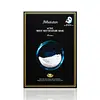What's inside
What's inside
 Key Ingredients
Key Ingredients

 Benefits
Benefits

 Concerns
Concerns

 Ingredients Side-by-side
Ingredients Side-by-side

Water
Skin ConditioningGlycereth-26
HumectantPPG-17
Skin ConditioningGlycerin
HumectantHydroxyethyl Urea
HumectantPhenoxyethanol
PreservativeTrehalose
HumectantArginine
MaskingBetaine
HumectantPanthenol
Skin ConditioningNiacinamide
SmoothingAllantoin
Skin ConditioningEthylhexylglycerin
Skin ConditioningMaltodextrin
AbsorbentButylene Glycol
HumectantXanthan Gum
EmulsifyingPolysorbate 20
EmulsifyingHydroxyethylcellulose
Emulsion StabilisingParfum
MaskingXylitylglucoside
HumectantCarbomer
Emulsion StabilisingHydrolyzed Vegetable Protein
Skin ConditioningSaccharide Hydrolysate
HumectantAnhydroxylitol
HumectantDisodium EDTA
Adenosine
Skin ConditioningXylitol
HumectantSodium Hyaluronate
HumectantPropanediol
SolventAlcohol
AntimicrobialGlucose
HumectantSodium Hyaluronate Crosspolymer
HumectantHydrolyzed Glycosaminoglycans
HumectantPEG-40 Hydrogenated Castor Oil
EmulsifyingBenzyl Glycol
SolventPPG-26-Buteth-26
Skin Conditioning1,2-Hexanediol
Skin ConditioningCaprylyl Glycol
EmollientHydrolyzed Hyaluronic Acid
HumectantPalmitoyl Tripeptide-5
Skin ConditioningCopper Tripeptide-1
Skin ConditioningPalmitoyl Tetrapeptide-7
Skin ConditioningAcetyl Hexapeptide-8
HumectantHyaluronic Acid
HumectantRaspberry Ketone
MaskingWater, Glycereth-26, PPG-17, Glycerin, Hydroxyethyl Urea, Phenoxyethanol, Trehalose, Arginine, Betaine, Panthenol, Niacinamide, Allantoin, Ethylhexylglycerin, Maltodextrin, Butylene Glycol, Xanthan Gum, Polysorbate 20, Hydroxyethylcellulose, Parfum, Xylitylglucoside, Carbomer, Hydrolyzed Vegetable Protein, Saccharide Hydrolysate, Anhydroxylitol, Disodium EDTA, Adenosine, Xylitol, Sodium Hyaluronate, Propanediol, Alcohol, Glucose, Sodium Hyaluronate Crosspolymer, Hydrolyzed Glycosaminoglycans, PEG-40 Hydrogenated Castor Oil, Benzyl Glycol, PPG-26-Buteth-26, 1,2-Hexanediol, Caprylyl Glycol, Hydrolyzed Hyaluronic Acid, Palmitoyl Tripeptide-5, Copper Tripeptide-1, Palmitoyl Tetrapeptide-7, Acetyl Hexapeptide-8, Hyaluronic Acid, Raspberry Ketone
Water
Skin ConditioningGlycerin
HumectantAlcohol
AntimicrobialHydroxyethylcellulose
Emulsion StabilisingPolysorbate 80
EmulsifyingBetaine
HumectantCentella Asiatica Extract
CleansingHamamelis Virginiana Extract
AntiseborrhoeicCamellia Sinensis Extract
AntioxidantCitrus Nobilis Peel Extract
MaskingCeramide NP
Skin ConditioningSodium Hyaluronate
HumectantCarbomer
Emulsion StabilisingTriethanolamine
BufferingDisodium EDTA
Phenoxyethanol
PreservativeAroma
Ingredients Explained
These ingredients are found in both products.
Ingredients higher up in an ingredient list are typically present in a larger amount.
Alcohol comes in many different forms. Different types of alcohol will have different effects on skin. This ingredient is usually an astringent alcohol.
These alcohols are drying on the skin. They may strip away your skin's natural oils and even damage your skin barrier. Astringent alcohols may also irritate skin.
Other types of astringent alcohols include:
According to the National Rosacea Society based in the US, you should be mindful of products with these alcohols in the top half of ingredients.
Any type of sanitizing product will have high amounts of alcohol to help kill bacteria and viruses.
Fatty alcohols come from plant oils such as coconut oil. These can help hydrate the skin and are non-irritating. Some fatty alcohols include cetyl and stearyl alcohol.
Learn more about AlcoholBetaine is a common humectant (a substance that promotes retention of moisture). It's known to be gentle on the skin and can help balance hydration.
This ingredient is best for improving hydration and soothing irritated skin. Studies also show it helps even out skin tone.
Fun fact: Betaine is naturally created in the skin and body. The kind found within cosmetic products can be either plant-derived or synthetic.
Another name for betaine is trimethylglycine.
Learn more about BetaineCarbomer is a polymer of acrylic acid. Its main role is to create a gel consistency.
A high amount of carbomer can cause pilling or balling up of products. Don't worry, most products contain 1% or less of carbomer.
Disodium EDTA plays a role in making products more stable by aiding other preservatives.
It is a chelating agent, meaning it neutralizes metal ions that may be found in a product.
Disodium EDTA is a salt of edetic acid and is found to be safe in cosmetic ingredients.
Learn more about Disodium EDTAGlycerin is already naturally found in your skin. It helps moisturize and protect your skin.
A study from 2016 found glycerin to be more effective as a humectant than AHAs and hyaluronic acid.
As a humectant, it helps the skin stay hydrated by pulling moisture to your skin. The low molecular weight of glycerin allows it to pull moisture into the deeper layers of your skin.
Hydrated skin improves your skin barrier; Your skin barrier helps protect against irritants and bacteria.
Glycerin has also been found to have antimicrobial and antiviral properties. Due to these properties, glycerin is often used in wound and burn treatments.
In cosmetics, glycerin is usually derived from plants such as soybean or palm. However, it can also be sourced from animals, such as tallow or animal fat.
This ingredient is organic, colorless, odorless, and non-toxic.
Glycerin is the name for this ingredient in American English. British English uses Glycerol/Glycerine.
Learn more about GlycerinHydroxyethylcellulose is used to improve the texture of products. It is created from a chemical reaction involving ethylene oxide and alkali-cellulose. Cellulose is a sugar found in plant cell walls and help give plants structure.
This ingredient helps stabilize products by preventing ingredients from separating. It can also help thicken the texture of a product.
This ingredient can also be found in pill medicines to help our bodies digest other ingredients.
Learn more about HydroxyethylcellulosePhenoxyethanol is a preservative that has germicide, antimicrobial, and aromatic properties. Studies show that phenoxyethanol can prevent microbial growth. By itself, it has a scent that is similar to that of a rose.
It's often used in formulations along with Caprylyl Glycol to preserve the shelf life of products.
Sodium Hyaluronate is hyaluronic acid's salt form. It is commonly derived from the sodium salt of hyaluronic acid.
Like hyaluronic acid, it is great at holding water and acts as a humectant. This makes it a great skin hydrating ingredient.
Sodium Hyaluronate is naturally occurring in our bodies and is mostly found in eye fluid and joints.
These are some other common types of Hyaluronic Acid:
Learn more about Sodium HyaluronateWater. It's the most common cosmetic ingredient of all. You'll usually see it at the top of ingredient lists, meaning that it makes up the largest part of the product.
So why is it so popular? Water most often acts as a solvent - this means that it helps dissolve other ingredients into the formulation.
You'll also recognize water as that liquid we all need to stay alive. If you see this, drink a glass of water. Stay hydrated!
Learn more about Water